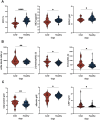Iron deficiency in dogs suffering from atopic dermatitis
- PMID: 39506866
- PMCID: PMC11539295
- DOI: 10.1186/s12917-024-04350-y
Iron deficiency in dogs suffering from atopic dermatitis
Abstract
Background: Iron-deficiency is associated with increased morbidity and mortality in non-communicable diseases. However, iron parameters are rarely assessed in dogs. Here, we aimed to assess and correlate iron parameters in dogs suffering from Canine Atopic Dermatitis (CAD) compared to non-atopic, healthy dogs.
Results: For this retrospective study, blood values and sera of 34 dogs with confirmed CAD were compared with 94 healthy non-atopic dogs. In our cohort, dogs with CAD had significantly lower mean corpuscular volume (MCV, ) mean corpuscular hemoglobin (MCH) but higher white blood cell counts due to increased levels of circulating neutrophils and monocytes. CAD patients also had elevated total protein and c-reactive protein (CRP), but lower albumin levels compared to our healthy control dogs, indicated low-grade inflammation in the CAD cohort. Spearman correlations associated negatively clinical symptom (CADESI-4/PVAS) with MCV; ceruloplasmin and hepcidin, but positively with serum iron. Only in the CAD-cohort, MCV, CRP and albumin-levels negatively affected serum iron-levels and were positively associated with ceruloplasmin. Linear regression analysis revealed that serum iron-levels in CAD subjects, were positively dependent on hematocrit (packed cell volume, PCV) and albumin, and negatively dependent with white blood cells and neutrophils numbers. In contrast, in the healthy cohort, hepcidin was the sole factor associated with serum iron.
Conclusions: A decreased iron status was associated with a higher symptom burden. Iron homeostasis differed markedly in healthy and atopic dermatitis dogs. CAD patients had depleted iron-stores and presented themselves with subclinical inflammation.
© 2024. The Author(s).
Conflict of interest statement
FRW is lead- and EJJ co-inventor of patent EP2894478, owned by Biomedical International R+D GmbH, of which EJJ is shareholder. FRW is founder of ViaLym, has served as an investigator and received personal fees from Biomedical Int R&D, Allergy Therapeutics, Bencard Allergy and Lofarma. The other authors declare no competing interests.
Figures




References
-
- Sato S. Iron deficiency: structural and microchemical changes in hair, nails, and skin. Semin Dermatol. 1991;10(4):313–9. - PubMed
-
- Stojkovic A, Radlovic N, Vuletic B, Nestorovic B, Lekovic Z, Obradovic S, et al. Presentation of an infant with nutritional deficiency dermatitis as the initial manifestation of cystic fibrosis. Srp Arh Celok Lek. 2013;141(11–12):810–3. - PubMed
MeSH terms
Substances
LinkOut - more resources
Full Text Sources
Medical
Research Materials
Miscellaneous

